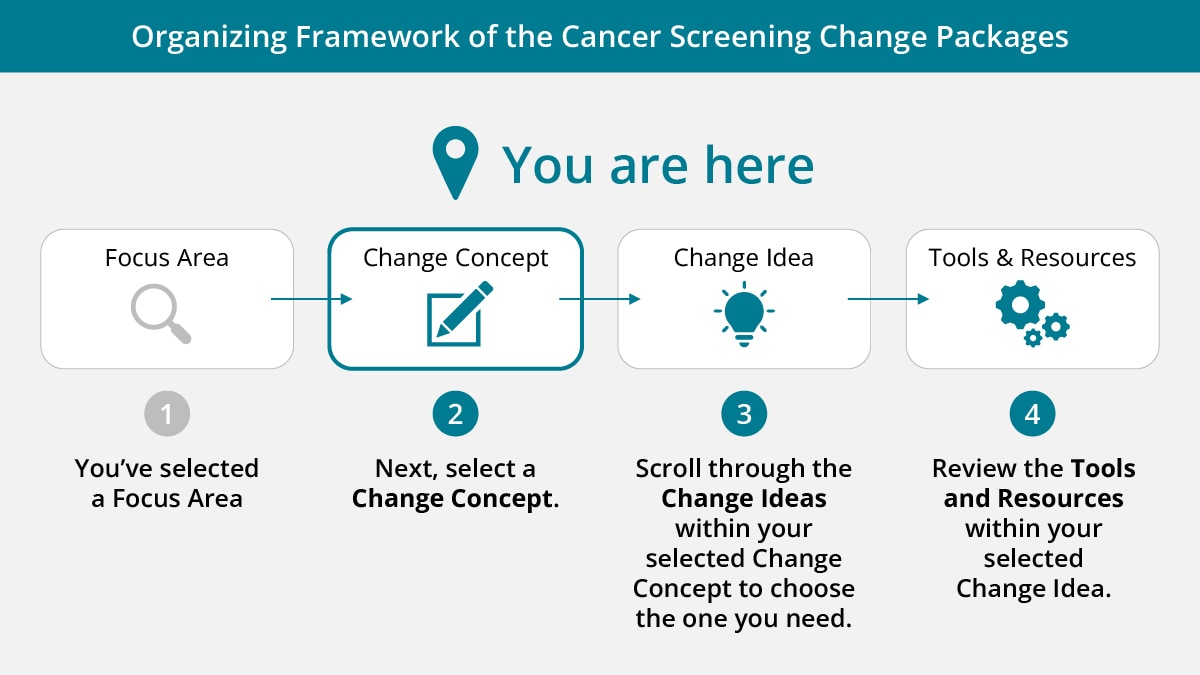What to know
The screening policies, procedures, and practices within health facilities focus area includes tools and resources to: assess the status of cancer screening, make cancer screening a priority, reduce structural barriers, and use data to identify patients due for screening and opportunities to improve cancer screening rates within a clinical setting or system.

Introduction
This page is part of the Colorectal Cancer Screening Change Package.

Change concepts are "general notions that are useful for developing more specific strategies for changing a process."1 Change ideas are evidence-based or practice-based "actionable, specific ideas or strategies."1 Each change idea is linked to tools and resources that can be used or adapted to improve cancer screening.
Note: See a list of acronyms used in this change package.
Select a change concept:
- Make cancer screening a priority.
- Implement population management strategies for all eligible patients.
- Establish standard operating procedures for screening.
- Use risk assessment tools and follow-up.
- Practice patient education, communication, and shared decision-making.
- Implement patient and provider reminder systems.
- Reduce structural barriers in the health care setting.
Change concept: Make cancer screening a priority.
- AICAF and NIHB — Advancing Health Systems Toolkit,A pages 5–7
- CDC, NACDD, and Kaiser Permanente CHR — Mailed FIT Implementation Guide, pages 11–14
- Health Promotion Practice Journal — The Health Promotion Practice Podcast: S2 Ep. 24 Exploring Sustainability Factors for a Colorectal Cancer Screening Program with Dara Schlueter
- NACHC — Value Transformation Framework: Cancer Screening, page 4
- CDC, NACDD, and Kaiser Permanente CHR — Mailed FIT Implementation Guide, pages 9–12
- Evidence-Based Cancer Control Programs (EBCCP) — Fecal Immunochemical Test and Colonoscopy Outreach,A see Program Materials [English and Spanish]
- AICAF and NIHB — Advancing Health Systems Toolkit,A pages 5–7
- NQF — ABCs of Measurement
Change concept: Implement population management strategies for all eligible patients.
- ACS — Cancer Facts and Figures for African American/Black People 2022–2024
- ACS — Cancer Prevention and Early Detection Facts and Figures 2022, (tables and figures only) pages 35–36
- CDC — United States Cancer Statistics: Data Visualizations Tool (see Screening and Risk Factors tab)
- NACHC — Value Transformation Framework: Cancer Screening, page 5
- NCQA — Cervical Cancer Screening (CCS)
- ACS and CCCNP — Comprehensive Cancer Control Plan: Colorectal Cancer Tip Sheet, pages 4–7
- BMC and AVON Foundation for Women — The Boston Medical Center Patient Navigation Toolkit, 1st ed, pages 10–19
- AICAF and NIHB — Advancing Health Systems Toolkit,A page 15
- Evidence-Based Cancer Control Programs (EBCCP) — Smart Options for Screening (SOS),A see Program Materials: Implementation Guide and SOS ICD Codes
- CDC — United States Cancer Statistics (USCS): Data Visualizations Tool
- NACHC — Value Transformation Framework: Cancer Screening, page 5
- NIH, NCI, and CDC — State Cancer Profiles Interactive Maps
Change concept: Establish standard operating procedures for screening.
- NACHC — Value Transformation Framework: Cancer Screening, pages 6–7
- CDC, NACDD, and Kaiser Permanente CHR — Mailed FIT Implementation Guide, pages 11–14
- CCSPSC — CCSPSC Champions Program, see Phased Approach to Implementation with Partners (throughout document)
- CCSPSC — CCSPSC Champions Program, see Sandhills-Lugoff Provider Reminder Process, page 32
- Evidence-Based Cancer Control Program (EBCCP) — Fecal Immunochemical Test and Colonoscopy Outreach, see Program Materials: Colonoscopy Strategy Workflow and FIT Strategy Workflow
- FluFIT, Potter M — FLU-FOBT Program Components and Flow DiagramA
- NACHC — Value Transformation Framework: Cancer Screening,A pages 5–8
Change concept: Practice patient education, communication, and shared decision-making.
- GW Cancer Center — Guide for Patient Navigators: A Supplement to the Oncology Patient Navigator Training: The Fundamentals, pages 83–88
- Kunneman M, Montori VM, Castaneda-Guarderas A, Hess EP, 2016 — What Is Shared Decision Making? (and What It Is Not)
- Ottawa Hospital Research Institute — Colon Cancer: Which Screening Test Should I Have?A
- AICAF and NIHB — Advancing Health Systems Toolkit,A B page 10
- ASCO — ColonoscopyB [English and Spanish]
- CDC — Colorectal Cancer Communication ResourcesB [videos and print materials in English and Spanish]
- Kaiser Permanente CHR — Patient Frequently Asked QuestionsB [English and Spanish]
- ACS — Insurance Coverage for Colorectal Cancer ScreeningB [English and Spanish]
- AGA — What to Expect: Paying for Your ColonoscopyB
- GW Cancer Center — Health Equity Toolbox: Resources to Foster Cultural Sensitivity and Equitable Care for All
- GW Cancer Center — Practice Patient-Centered Care Posters
- GW Cancer Center — Practice Patient-Centered Care Posters
- Evidence-Based Cancer Control Programs (EBCCP) — Fecal Immunochemical Test and Colonoscopy Outreach,A Bsee Program Materials: Colonoscopy Invitation Letter [English and Spanish example letters] and Colonoscopy Bowel Prep Instructions [English and Spanish examples]
Change concept: Implement patient and provider reminder systems.
- AltaMed, Kaiser Permanente CHR — PROMPT Study: Primer Calls for Never Completed FIT Screening: Outreach Team Call Scripts [English and Spanish patient letter, personalized alert, and reminder prompts for FIT]
- CDC, NACDD, and Kaiser Permanente CHR — Mailed FIT Implementation Guide, pages 24, 28, 32, and 38
- Evidence-Based Cancer Control Programs — Against Colorectal Cancer In Our Neighborhoods (ACCION) — FIT Abnormal Results LetterA B[English and Spanish]
- Evidence-Based Cancer Control Programs — Fecal Immunochemical Test and Colonoscopy Outreach [English and Spanish colonoscopy appointment reminder, FIT telephone scripts]
- Evidence-Based Cancer Control Programs — Smart Options for Screening (SOS) — Implementation Guide
- Kaiser Permanente CHR — Prevention Research Center Colorectal Cancer Mailed Patient Reminder TemplateB [English and Spanish]
- Kaiser Permanente CHR — Reminder Call Phone Scripts to Return FIT Tests
- Kaiser Permanente CHR — Vendor Script: Colorectal Cancer Screening FOBT Kits
- NIHB — Health Systems Improvement Toolkit: A Guide to Cancer Screenings in Indian Country,A pages 15 and 21–24
- Washington State Department of Health — Colon Cancer Screening Provider Toolbox, page 1
- ACS and CCCNP — Comprehensive Cancer Control Plan: Colorectal Cancer Tip Sheet, page 9
- AICAF and NIHB — Advancing Health Systems Toolkit,A page 15
- CCSPSC — CCSPSC Champions Program, see Provider Reminder Observation Form, pages 33–35, and Sandhills-Lugoff Provider Reminder Process, page 32
- CDC — Evidence-Based Interventions — Provider Reminder Planning Guide
- NIHB — Health Systems Improvement Toolkit: A Guide to Cancer Screenings in Indian Country,A pages 15 and 17–19
- CCSPSC — CCSPSC Champions Program, see Provider Reminder Observation Form, pages 33–35
- CDC — Evidence-Based Interventions – Provider Reminder Planning Guide
- NIHB — Health Systems Improvement Toolkit: A Guide to Cancer Screenings in Indian Country, pages 15 and 17–19
Change concept: Reduce structural barriers in the health care setting.
- Centers for Medicare and Medicaid Services — Accountable Health Communities Model [social needs screening tool]
- President's Cancer Panel — Closing Gaps in Cancer Screening: Connecting People, Communities, and Systems to Improve Equity and Access, pages 3 and 17–19
- BMC and AVON Foundation for Women — The Boston Medical Center Patient Navigation Toolkit 1st ed
- Evidence-Based Cancer Control Programs (EBCCP) — Kukui Ahi (Light the Way): Patient Navigation — Addressing Barriers Worksheet; Implementation Guide
- GW Cancer Institute — Guide for Patient Navigators: A Supplement to the Oncology Patient Navigator Training: The Fundamentals
- NCCRT and Colorado School of Public Health — Paying for Colorectal Cancer Screening Patient Navigation Toolkit and Interactive Website
- NIHB — Health Systems Improvement Toolkit: A Guide to Cancer Screenings in Indian Country, pages 25–26
- Juckett G, Unger K, 2014 — Appropriate Use of Medical Interpreters
- NIHB — Health Systems Improvement Toolkit: A Guide to Cancer Screenings in Indian Country, page 25
- The Community Guide — Cancer Screening: Reducing Structural Barriers for Clients — Breast Cancer
- NACHC — Value Transformation Framework: Cancer Screening, pages 6–9
- NIHB — Health Systems Improvement Toolkit: A Guide to Cancer Screenings in Indian Country, page 25
- The Community Guide — Cancer Screening: Reducing Structural Barriers for Clients — Breast Cancer
- NACHC — Value Transformation Framework: Cancer Screening, pages 6–9
- BMC and AVON Foundation for Women — The Boston Medical Center Patient Navigation Toolkit 1st ed, pages 5–19
- CCSPSC — CCSPSC Champions Program, see Readiness Assessment, pages 1–5
- Evidence-Based Cancer Control Programs (EBCCP) — Kukui Ahi (Light the Way): Patient Navigation — Facility Tour Worksheet
- Centers for Disease Control and Prevention. Tobacco Cessation Change Package. US Department of Health and Human Services; 2019.
- This resource may contain some information that does not reflect the current US Preventive Services Task Force recommendations for cervical cancer screening.
- Indicates a patient resource.
